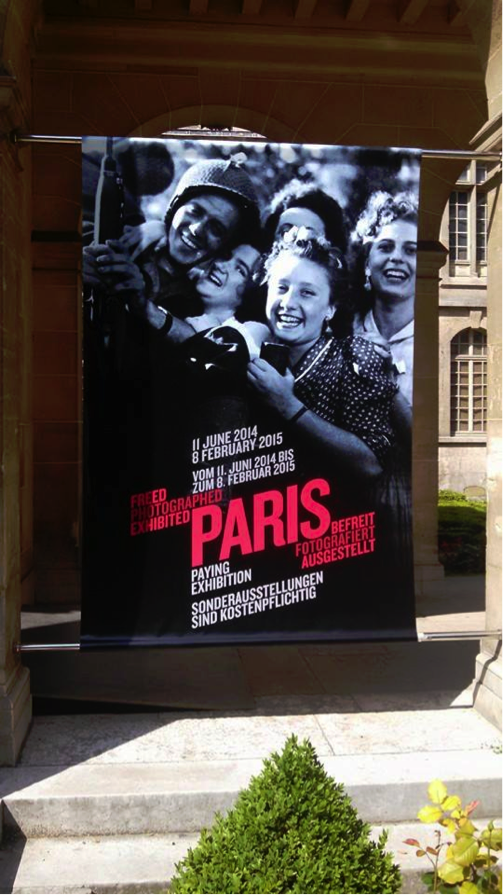By Mike Griffen
On August 25, 1944, General Dietrich Von Choltitz, leader of the German occupying forces in Paris, formally surrendered to combined Free French and Allied Forces at Le Hôtel Meurice. Later that day Charles de Gaulle, leader of the Free French forces, made his infamous liberation speech.
“Paris! Paris outraged! Paris broken! Paris martyred! But Paris liberated! Liberated by itself, liberated by its people with the help of the French armies, with the support and the help of all France, of the France that fights, of the only France, of the real France, of the eternal France!”
These words, which not so subtly omit the Allies’ part in the city’s liberation, had a profound effect on Parisian memory of the events and the perception of the context in which they occurred.
The Musée Carnavalet in Paris’ 3rd Arrondissement is dedicated to the city’s history. On June 11 the museum celebrated the grand opening of a photographic exhibit in honor of the 70th anniversary of the liberation.
Under the slogan, “Paris liberated, Paris photographed, Paris exposed,” the exhibit told the story of the battle for Paris and its aftermath through the works of French photographers. A vast collection of stirring pictures by the likes of Robert Doisneau, René Zuber, Jean Séeberger were displayed. They told the story of the struggles of the Free French and the Resistance to rescue their city.
On the surface, the exhibition features nothing out of the ordinary. But it’s what it does not contain that raises some questions. For any observant American or Brit who navigates and closely examines their way through the five room collection of photos and original films, a question is raised: what about the Allies?
Of the nearly 400 photographs on display, no more than 15 feature Allied soldiers as the focal point. The vast majority of the photos are of Free French or Resistance forces and about 80-100 are of de Gaulle.
To an extent, this is certainly understandable. The exhibit is a revival of a 1944 exhibit organized by the museum’s curator a month after the city was freed.
Because of the proximity to the events of the battle of Paris, the original exhibition was largely based on emotion rather than historical accuracy. This bias is clearly evident in its modern revival due to the fact that about a third of the photos were in the original exhibit.
Probably the most shocking part of the experience, from an American perspective, comes at the very end of the tour. On the wall, next to the exit, are three paragraphs titled “THE AMERICANS,” one in French, one in English, one in German. The English version, a loose translation of the French, states:
“The Americans landed on the shores of Europe to combat Nazi bigotry, hatred, and evil. There is “a certain level of irony given the amount of racism and segregation in their own army.” It goes on to say, “The United States Army was completely segregated and no black soldiers were allowed in combat units.”
This is the only part of the entire exhibit in which the Americans are mentioned in any sort of detail and there is no aura of gratitude, only indifference, even contempt.
It is entirely true that segregation and racism played an important role in WWII and the liberation of Paris. When the French 2nd Armored, a highly diverse division, prepared to enter the city, General Eisenhower’s Chief of Staff issued a letter demanding that the French Army be segregated during the liberation attempt. Understandably, this gave the French a negative impression of American tolerance.
However, the claim that there were no black combat units can be refuted by a simple Google search. Over 70 units of African-Americans served on the front-lines during World War II, including 3 at the beaches of Normandy.
It is hard to say why a famous museum such as the Musée Carnavalet would state this falsehood as fact. From an American perspective, it is almost a slap in the face. But the segregation of the US Army is a truth that has been glossed over for the past 70 years.
American and French memories of the liberation of Paris are contradictory yet, in some ways, cohesive. Both sides know what happened. Even de Gaulle admitted that his was a primarily patriotic speech aimed at raising the moral of the French. In late 1944, Eisenhower allowed black soldiers to join white units at the Battle of the Bulge. He went on to be a major advocate for desegregation during his presidency.
It is human nature to pick and choose how you wish to remember the way events unfolded. In the same way a pathological liar eventually believes the tall tales he tells, selective memory of past events, when taught as truth, becomes reality in the minds of those who reinforce it. When certain facts are brushed under the carpet, it is to the detriment of all involved. It stymies progress and prevents society from actually fixing the issue, no matter how uncomfortable it may be.
The truth of the matter is that it is a fruitless debate to argue over who receives credit for the liberation. The city was freed, and neither side could have prevailed without the other, and that is worthy of commemoration.

